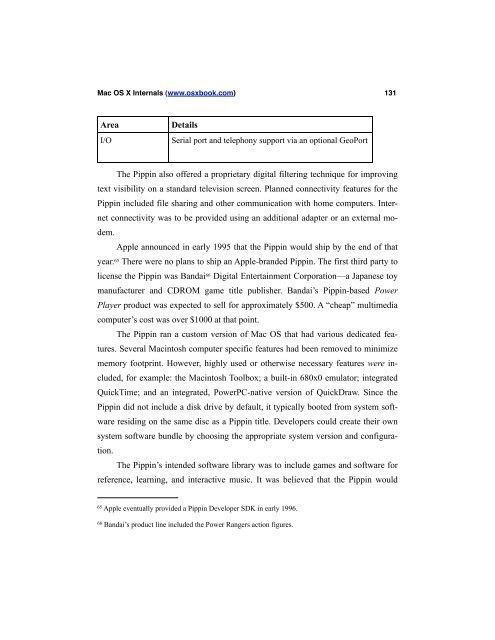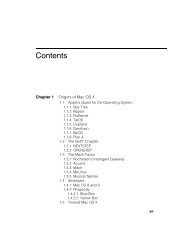A Technical History of Apple's Operating Systems - Mac OS X Internals
A Technical History of Apple's Operating Systems - Mac OS X Internals
A Technical History of Apple's Operating Systems - Mac OS X Internals
You also want an ePaper? Increase the reach of your titles
YUMPU automatically turns print PDFs into web optimized ePapers that Google loves.
<strong>Mac</strong> <strong>OS</strong> X <strong>Internals</strong> (www.osxbook.com) 131<br />
Area Details<br />
I/O Serial port and telephony support via an optional GeoPort<br />
The Pippin also <strong>of</strong>fered a proprietary digital filtering technique for improving<br />
text visibility on a standard television screen. Planned connectivity features for the<br />
Pippin included file sharing and other communication with home computers. Inter-<br />
net connectivity was to be provided using an additional adapter or an external mo-<br />
dem.<br />
Apple announced in early 1995 that the Pippin would ship by the end <strong>of</strong> that<br />
year. 65 There were no plans to ship an Apple-branded Pippin. The first third party to<br />
license the Pippin was Bandai 66 Digital Entertainment Corporation—a Japanese toy<br />
manufacturer and CDROM game title publisher. Bandai’s Pippin-based Power<br />
Player product was expected to sell for approximately $500. A “cheap” multimedia<br />
computer’s cost was over $1000 at that point.<br />
The Pippin ran a custom version <strong>of</strong> <strong>Mac</strong> <strong>OS</strong> that had various dedicated fea-<br />
tures. Several <strong>Mac</strong>intosh computer specific features had been removed to minimize<br />
memory footprint. However, highly used or otherwise necessary features were in-<br />
cluded, for example: the <strong>Mac</strong>intosh Toolbox; a built-in 680x0 emulator; integrated<br />
QuickTime; and an integrated, PowerPC-native version <strong>of</strong> QuickDraw. Since the<br />
Pippin did not include a disk drive by default, it typically booted from system s<strong>of</strong>t-<br />
ware residing on the same disc as a Pippin title. Developers could create their own<br />
system s<strong>of</strong>tware bundle by choosing the appropriate system version and configura-<br />
tion.<br />
The Pippin’s intended s<strong>of</strong>tware library was to include games and s<strong>of</strong>tware for<br />
reference, learning, and interactive music. It was believed that the Pippin would<br />
65 Apple eventually provided a Pippin Developer SDK in early 1996.<br />
66 Bandai’s product line included the Power Rangers action figures.




